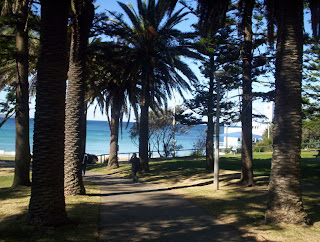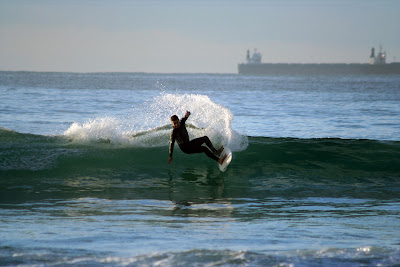 |
| Coogee 1900 |
Aboriginal
The name Coogee is said to be taken from a local Aboriginal word koojah which means "smelly place". Another version is koo-chai or koo-jah: the smell of the seaweed drying (Bidigal language). or "stinking seaweed", a reference to the smell of decaying kelp washed up on the beach. Although at certain times large quantities of seaweed are still washed up, it is usually removed before it gets a chance to stink. Coastal winds can carry the stench to surrounding suburbs and as far westwards as the University of New South Wales.
Early visitors to the area, from the 1820s onwards, were never able to confirm exactly what "Coogee" meant, or if it in fact related to Coogee Beach. Another name, "Bobroi", was also recalled as the indigenous name for the locality.
Some evidence suggests that the word "Coogee" may in fact be the original Aboriginal place name for the next bay to the north, now known as Gordon's Bay.
The Aboriginal population had largely relocated by the mid-19th century after being decimated by disease and violent clashes with early settlers, though some Aborigines still live in the area today.
 |
| View from the baths |
European settlement
Coogee was gazetted as a village in 1838, in 1863 the first school was built which was later converted to become the Coogee Bay Hotel in 1873, three years later in 1876 Coogee Public School was established. In late 1887, Coogee Palace Aquarium and swimming baths followed by the construction of the Coogee pier in 1928 which was later demolished in 1934.
Coogee was connected to the City of Sydney by electric tram in 1902. The suburb's popularity as a seaside resort was then guaranteed. The line branched from the line to Clovelly at Darley Rd in Randwick. It ran down King St beside the Randwick Tram Workshops, then ran in its own reservation to Belmore Rd. It then ran down Perouse Rd, St Pauls St, Carr St and Arden St before terminating in a balloon loop in Dolphin St at Coogee Beach. It ran through several small tram reservations on its way down from Randwick to the beach. The line from Randwick to Coogee opened in 1883, and electric services were introduced in 1902. The line closed in 1960. It follows the current route of bus 373.
The Coogee Surf Life Saving Club was founded in 1907. Population growth began in earnest in the 1920s. An English-style seaside entertainment pier stood at the beach between 1928 and 1934, but it was demolished after serious damage by the surf.
Built in the early 1890s and occupied by a Mrs T.M. Alcock was a large mansion known as Maidstone, which stands in Waltham Street beside St Brigid's Church.The house features a metal cupola and cedar fittings inside. The Catholic Church bought the building in 1922 and it was restored to its original style by Provincial House of the Missionaries of the Sacred Heart.
Located in Alison Road is a two-storey Federation mansion named Ocean View. The house was built in 1916 by Philip Wirth, of Wirth's Circus.
 |
| Coogee Pier, courtesy, State Library of New South Wales |
Coogee Palace Aquarium (1887-1986)
The Coogee Aquarium and Swimming Baths were officially opened on 23 December 1887, it covered a block of land bordered by Arden Street, Beach Street, Bream Street and Dolphin Street. The Palace included an indoor Swimming pool (25 x 10 meters), an aquarium featuring the tiger shark from the famous shark arm murder case, a Great Hall that could be used as a roller skating rink, Canadian toboggan ran down the hillside for over 70 meters, a herd of 14 donkeys to ride as well as swings, whirligig's rocking horses, toy boats, aviaries, flower beds, bandstand and an open air bar.
In June 1945, a strong storm caused the large dome to collapse, in 1987 the Coogee Palace and Dome was re-built and converted to restaurants and bars. The current hotel on the premises is owned by investment banker David Kingston and is known both as The Beach Palace Hotel and The Aquarium
 |
| Coogee Pier, courtesy State Library of New South Wales |
The Coogee Pier (1928-1934)
In 1924 construction started to build an 'English seaside style' amusement pier at Coogee Beach, on 24 July 1928, the pier was officially opened, reaching 180 meters out into the sea complete with a 1400 seat theatre, a 600 capacity ballroom, a 400 seat restaurant upstairs, small shops and a penny (machine) arcade. Unfortunately Coogee's rough surf damaged the pier and it was demolished in 1934. Life guards have recently discovered remains of the pier on the ocean floor about 50 meters out from shore.
Shark Arm Murder Case (1935)
The Shark Arm Case refers to an incident at the Coogee Aquarium Baths in 1935, when a captured tiger shark regurgitated a human arm. The arm belonged to a missing person, James Smith, and was identified by a tattoo. The arm had been cut off, which led to a murder investigation. Nobody was ever charged over the murder, although another local criminal, Reginald Holmes, was found shot in a car near the Sydney Harbour Bridge the day before the inquest into Smith's death was due to start.
Alleged Marian apparition (2003)
In January 2003 it was noticed that one of the fence rails on Dolphin Point, just north of Coogee Beach, when viewed from a particular angle and distance, resembled a veiled woman. A local laundrette was one of the first to draw attention to it, and set up a gallery of photos to attract visiting "pilgrims".
When the illusion was reported in newspapers many Christians (predominantly Roman Catholic) came daily to worship what they interpreted as an apparition of Mary, the mother of Jesus, although the Roman Catholic Church never officially recognised this alleged apparition of the Blessed Virgin Mary.
No particular supernatural powers were attributed to the shadow (dubbed "Our Lady of the Fence Post" by the media, aka "Rail Mary") and interest waned within a few weeks. The section of fence that created the image was destroyed by vandals within days of it being publicised, although the local council had the fence replaced. While some continue to petition the Catholic Church and the New South Wales government to build a chapel, their claims were not seriously considered.
 |
| Coogee Surf Club |
























































